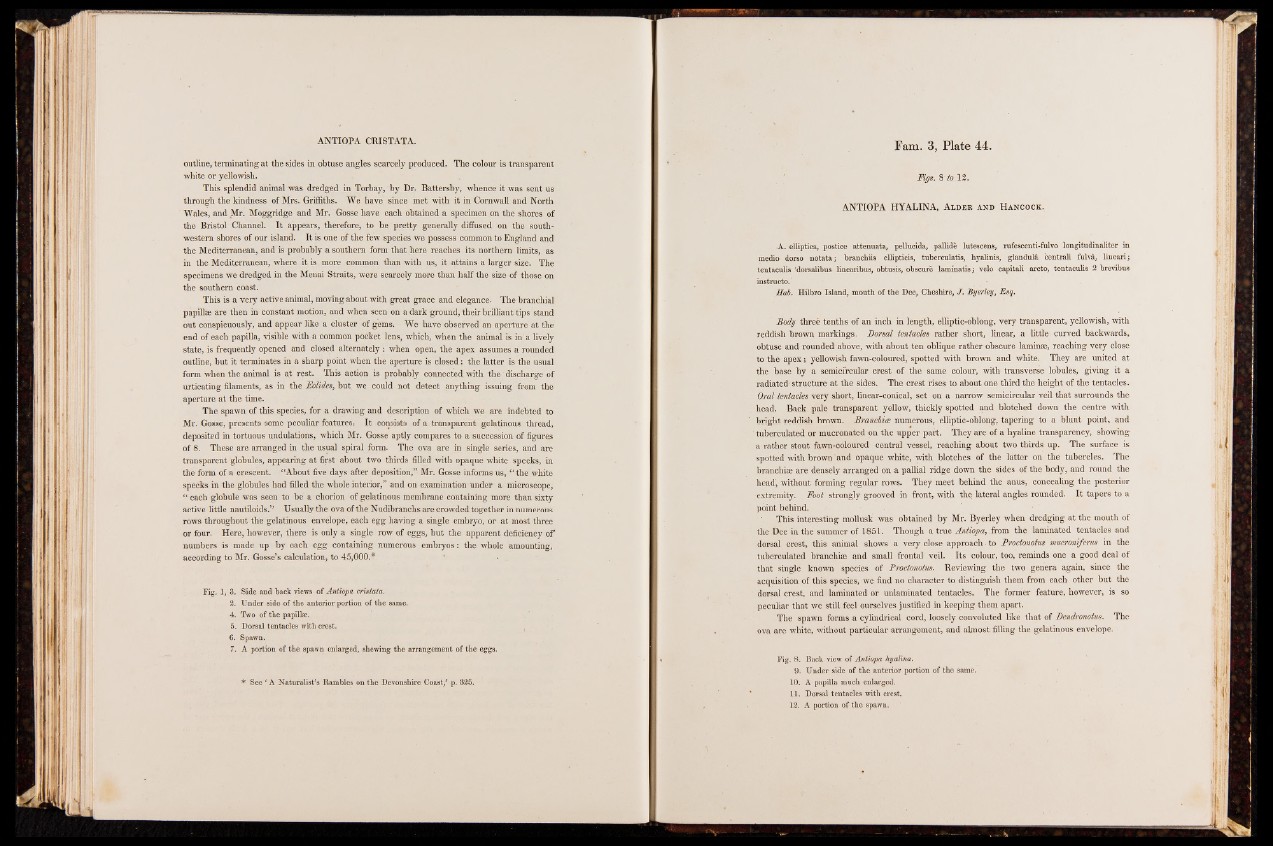
outline, terminating at the sides in obtuse angles scarcely produced. The colour is transparent
white or yellowish.
This splendid animal was dredged in Torbay, by Dr. Battersby, whence it was sent us
through the kindness of Mrs. Griffiths. We have since met with it in Cornwall and North
Wales, and Mr. Moggridge and Mr. Gosse have each obtained a specimen on the shores of
the Bristol Channel. It appears, therefore, to be pretty generally diffused on the southwestern
shores of our island. It is one of the few species we possess common to England and
the Mediterranean, and is probably a southern form that here reaches its northern limits, as
in the Mediterranean, where it is more common than with us, it attains a larger size. The
specimens we dredged in the Menai Straits, were scarcely more than half the size of those on
the southern coast.
This is a very active animal, moving about with great grace and elegance. The branchial
papillae are then in constant motion, and when seen on a dark ground, their brilliant tips stand
out conspicuously, and appear like a cluster of gems. We have observed an aperture at the
end of each papilla, visible with a common pocket lens, which, when the animal is in'a lively
state, is frequently opened and closed alternately : when open, the apex assumes a rounded
outline, but it terminates in a sharp point when the aperture is closed: the latter is the usual
form when the animal is at rest. This action is probably connected with the discharge of
urticating filaments, as in the Bolides, but. we could not detect anything issuing from the
aperture at the time.
The spawn of this species, for a drawing and description of which we are indebted to
Mr. Gosse, presents some peculiar features. It consists of a transparent gelatinous thread,
deposited in tortuous undulations, which Mr. Gosse aptly compares to a succession of figures
of 8. These are arranged in the usual spiral form. The ova are in single series, and are
transparent globules, appearing at first about two thirds filled with opaque white specks, in
the form of a crescent. “About five days after deposition,” Mr. Gosse informs us, “ the white
specks in the globules had filled the whole interior,” and on examination under a microscope,
“ each globule was seen to be a chorion of gelatinous membrane containing more than sixty
active little nautiloids/' Usually the ova of the Nudibranchs are crowded together in numerous
rows throughout the gelatinous envelope, each egg having a single embryo, or at most three
or four. Here, however, there is only a single row of eggs, but the apparent deficiency of
numbers is made up by each egg containing numerous embryos: the whole amounting,
according to Mr. Gosse’s calculation, to 45,000.* '$ •
Fig. 1, 3. Side and back views of Antiopa cristata.
2. Under side of the anterior portion of the same.
4. Two of the papilke.
5. Dorsal tentacles with crest.
6. Spawn.
7. A portion of the spawn enlarged, shewing the arrangement of the eggs.
* See f A Naturalist's Rambles on the Devonshire Coast/ p. 325.
Fiys. 8 to 12.
ANTIOPA HYALINA, Alder and Hancock.
A. elliptica, postice attenuata, pellucida, pallide lutescens, rufescenti-fulvo longitudinaliter in
medio dorso notataj branchiis ellipticis, tuberculatis, hyalinis, glandula centrali fulv&, lineari;
tentaculis 'dorsalibus linearibus, obtusis, obscure laminatis; velo capitali arcto, tentaculis 2 brevibus
instructo.
Hab. Hilbro Island, mouth of the Dee, Cheshire, J. Byerley, Esq.
Body three tenths of an inch in length, elliptic-oblong, very transparent, yellowish, with
reddish brown markings. Dorsal tentacles rather short, linear, a little curved backwards,
obtuse and rounded above, with about ten oblique rather obscure laminse, reaching very close
to the apex; yellowish fawn-coloured, spotted with brown and white. They are united at
the base by a semicircular crest of the same colour, with transverse lobules, giving it a
radiated- structure at the sides. The crest rises to about one third the height of the tentacles.
Oral tentacles very short, linear-conical, set on a narrow semicircular veil that surrounds the
head. Back pale transparent yellow, thickly spotted and blotched down the centre with
bright reddish brown. BrancMce numerous, elliptic-oblong, tapering to a blunt point, and
tuberculated or mucronated on the upper part. They are of a hyaline transparency, showing
a rather stout fawn-coloured central vessel, reaching about two thirds up. The surface is
spotted with brown and opaque white, with blotches of the latter on the tubercles. The
branchiae are densely arranged on a pallial ridge down the sides of the body, and round the
head, without forming regular rows. They meet behind the anus, concealing the posterior
extremity. Foot strongly grooved in front, with the lateral angles rounded. It tapers to a
point behind.
This interesting mollusk was obtained by Mr. Byerley when dredging at the mouth of
the Dee in the summer of 1851. Though a true Antiopa,.from the laminated tentacles and
dorsal crest, this animal shows a very close approach • to Broctonotus mucroniferus in the
tuberculated branchiae and small frontal veil. Its colour, too, reminds one a good deal of
that single known species of Broctonotus. Reviewing the two genera again, since the
acquisition of this species, we find no character to distinguish them from each other but the
dorsal crest, and laminated or unlaminated tentacles. The former feature, however, is so
peculiar that we still feel ourselves justified in keeping them apart.
The spawn forms a cylindrical cord, loosely convoluted like that of Dendronotus. The
ova are white, without particular arrangement, and almost filling the gelatinous envelope.
Fig. 8. Back view of Antiopa hyalina.
9. Under side of the anterior portion of the same.
10. A papilla much enlarged.
11. Dorsal tentacles with crest.
12. A portion of the spawn.